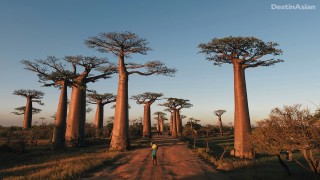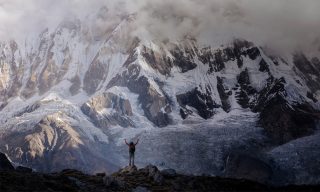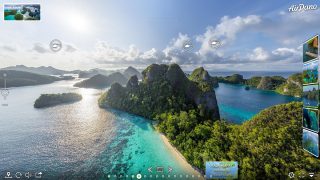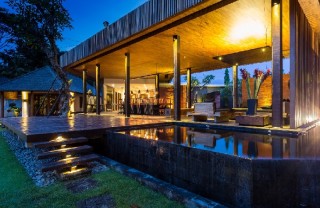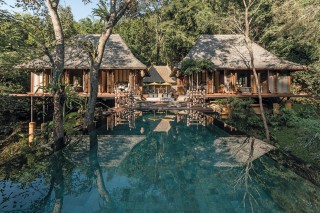From frescoed Thracian tombs to Byzantine monasteries and Soviet-era monuments, temptations abound on a journey into the mountain fastness of southern Bulgaria, where ancient traditions meet modern comforts.
By Warren Singh-Bartlett
Photographs by Petar Peshev
Shifting gears, Dimitr advised me to buckle up. “The snow’s still deep here but if we hit it hard, we should get across.” What we needed to get across was an icy saddle some 1,200 meters up in the Balkan Mountains. Our destination lay on the other side and a couple hundred meters farther up: Buzludzha, a massive saucer-shaped building made of concrete, behind which loomed a slender tower incised on either side with a red Soviet star. Even from here, it was clear Buzludzha had seen better days. Built at the apogee of Bulgarian Communism, under then general secretary Todor Zhivkov, this monument to the Party’s founders opened in 1981. Less than a decade later it was abandoned, as Bulgaria, along with the rest of Eastern Europe, began its transition toward democracy.
It took us a while to find what remained of the road up, a patchwork of asphalt and grass that rapidly disintegrated into a bumpy dirt track. “Hold on,” Dimitr cautioned. “If this doesn’t work, we might end up in that ditch down there.”
I wondered briefly if it was worth the risk. Buz-ludzha hadn’t been on our itinerary; technically, we were on our way to the village of Gela, up in the Rhodope Mountains that range along the old Iron Curtain border with Greece. But the drive from Sofia was littered with so much temptation that, rather than take the short route, we’d detoured through the town of Kazanlak and the Valley of the Thracian Rulers to marvel at 2,300-year-old rock-cut tombs, some still brightly frescoed. It was as we were on our way to Shushmanets, a temple turned tomb where ancient Thracian priests once locked themselves in the dark for three-day meditation sessions, that I spotted Buzludzha—a tomb, too, albeit of a modern sort. Even from below, the ridge-top monument was magnificent, lording over the wintry mountainscape. And inside it was more fascinating still, as I knew from photos I’d seen online of Buzludzha’s ruined, spaceship-like interior. Despite the post-apocalyptic splendor—fallen ceiling, gaping holes, crumbling seating—the main hall’s heroic mosaics were largely intact, as was the giant hammer-and-sickle emblem on the ceiling. Yes, I thought as I tightened my seat belt, it was worth a try.
Dimitr hit the accelerator. Kicking up a slurry of icy mud and yellowed turf, the Land Rover roared forward. Thirty seconds later, after sliding toward the aforementioned ditch a couple of times, we were across. From here on, the slope was mostly bare, stripped of snow by the ferocious wind. A few minutes later, I was racing up the front steps toward the main entrance. Of course, it was locked. Chained shut. I circumambulated the building as though it were some kind of Communist Kaaba looking for somewhere I could climb up or squeeze through. To no avail. The windows, smashed in by vandals years ago, were all plated shut, and while a small platform halfway up one of the side walls looked promising, I needed a rope or ladder to reach it. In the end, the only glimpse I had of that ruined interior was through a small hole in the steel plating at the main entrance. I was tempted to linger, but the clouds were closing in and the wind was picking up. Freezing, I conceded defeat.
As we drove away, my disappointment was mitigated by the fact that while I hadn’t managed to get inside, there had been something about the whole experience—Dimitr’s gung-ho approach, the trouble we had getting there, knowing that what we were doing was probably mildly illegal—that recalled the freewheeling sense of freedom I remember from my first years in Lebanon, where I’ve lived since 1998. So two hours later, as we drew into the garage beside our destination, an improbable oasis of luxury in most rural Bulgaria called Villa Gella, I was riding a high.
The drive had helped. Bulgaria is visibly poor and largely rural. You see the kinds of lined, weathered faces here that prosperity and rich diets have erased elsewhere in Europe. Buildings are dilapidated. Horse and donkey carts are still common; you even see them in Sofia, the capital. But this material poverty, an ephemeral condition, belies the country’s historical, natural, and cultural wealth. Glorious churches with blazing icons; ancient cities that are architectural palimpsests, testimony to thousands of years of invasion and occupation; stately Sinan-esque mosques and Beaux Arts synagogues; thickly forested mountains harboring bears, wolves, wild boar, and eagles; and Black Sea beaches, beautiful despite the massive resorts built along them under Pax Sovietica. Bulgaria was a revelation—a “wild beauty,” to borrow neighboring Montenegro’s marketing slogan. A pocket of old Europe and of old European cordiality.
We left the plains at Asenovgrad and snaked our way up into the mountains along the course of the Chepelare River, passing Byzantine monasteries, a 13th-century fortress, and countless signs pointing to some ruined castle, church, or temple. According to Dimitr, this road has been used by travelers between the Balkans and Greece for the last 3,000 years, possibly longer. Gradually, the valley narrowed and the forest closed in. As night fell, often the only lights visible were those of passing cars.

















